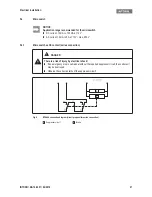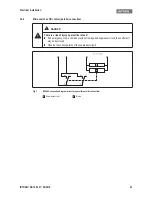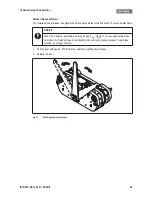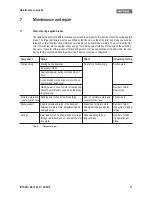
Troubleshooting and fault elimination
INTORQ | BA 14.0201 | 04/2016
34
8
Troubleshooting and fault elimination
If any malfunctions should occur when operating the braking system, please check for possible causes
based on the following table. If the fault cannot be fixed or eliminated by one of the listed measures, please
contact customer service.
Fault
Cause
Remedy
Brake does not release
The air gap is zero
Coil interruption
❚
Measure coil resistance using a multimeter:
- Compare the measured resistance with the nominal
resistance (
14).
- Replace the brake when the resistance is too high.
Coil has contact to earth or
between windings
❚
Measure the coil resistance using a multimeter:
- Compare the measured resistance with the nominal
resistance. Refer to
14 for the values. If resist-
ance is too low, replace the complete brake.
❚
Check the coil for short to ground using a multimeter:
- Replace the brake in case of short circuit to ground.
❚
Check the brake voltage (refer to section on defective
rectifier, voltage too low).
Wiring defective or wrong
❚
Check and correct
❚
cable for continuity using a multimeter
- Replace defective cable.
Rectifier defective or incorrect
❚
Measure rectifier DC voltage using a multimeter.
If DC voltage is zero:
❚
Check AC rectifier voltage.
If AC voltage is zero:
- Switch on power supply
- Check fuse
- Check wiring.
- Check microswitch
If AC voltage is okay:
- Check rectifier,
- Replace defective rectifier
Measure the DC voltage:
- Overexcitation 90 V (approx. 1 sec.) holding voltage
45 V (tolerance ±10 %)
❚
Check coil for inter-turn fault or short circuit to ground.
❚
If the rectifier defect occurs again, replace the entire
stator, even if you cannot find any fault between turns or
short circuit to ground. The error may only occur on
warming up.
Air gap too big
Replace the brake (
33)





































